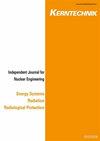Determination of limiter design and material composition of MT-II spherical tokamak
IF 0.4
4区 工程技术
Q4 NUCLEAR SCIENCE & TECHNOLOGY
引用次数: 2
Abstract
Abstract MT-II is a spherical tokamak with a major radius of 0.15 m and a minor radius of 0.09 m, currently under development at the Pakistan Tokamak Plasma Research Institute. It is designed with a higher elongation of 2.67. This paper presents the design and material analysis of the limiter configuration for the MT-II tokamak, which is being carried out in two phases. In the first phase, theoretical studies and calculations are performed to estimate the plasma edge temperature, density, particle velocity, input power, heat flux, heat load and surface temperature on the limiter tile. In the second phase, computational techniques are applied to analyses the material properties, the maximum/minimum surface temperature rise (∆T °C) at stable heat load and power deposition based on theoretical calculations that will help optimize the design parameters of the limiter. The type of material and the surface temperature of the limiter as well as the general design parameters of MT-II are included in the proposed poloidal limiter. The results suggest that crystalline vein graphite is a suitable candidate for the proposed poloidal limiter. A combination of mechanical and electrical feedthrough techniques are used to improve the performance of the limiter. The proposed limiter is able to meet the requirements of MT-II.MT-II型球形托卡马克限制器设计及材料组成的确定
MT-II是一个球形托卡马克,主要半径为0.15 m,次要半径为0.09 m,目前正在巴基斯坦托卡马克等离子体研究所开发。其设计伸长率为2.67。本文介绍了MT-II型托卡马克限制器结构的设计和材料分析,该设计分两个阶段进行。在第一阶段,进行了理论研究和计算,估计了等离子体边缘温度、密度、粒子速度、输入功率、热流密度、热负荷和限制瓦表面温度。在第二阶段,应用计算技术分析材料性能,稳定热负荷下最大/最小表面温升(∆T°C)和基于理论计算的功率沉积,这将有助于优化限位器的设计参数。所提出的极向限幅器包含了材料类型、限幅器的表面温度以及MT-II的一般设计参数。结果表明,晶体脉状石墨是极向限制器的理想材料。机械和电馈通技术的结合被用来提高限制器的性能。所提出的限幅器能够满足MT-II的要求。
本文章由计算机程序翻译,如有差异,请以英文原文为准。
求助全文
约1分钟内获得全文
求助全文
来源期刊

Kerntechnik
工程技术-核科学技术
CiteScore
0.90
自引率
20.00%
发文量
72
审稿时长
6-12 weeks
期刊介绍:
Kerntechnik is an independent journal for nuclear engineering (including design, operation, safety and economics of nuclear power stations, research reactors and simulators), energy systems, radiation (ionizing radiation in industry, medicine and research) and radiological protection (biological effects of ionizing radiation, the system of protection for occupational, medical and public exposures, the assessment of doses, operational protection and safety programs, management of radioactive wastes, decommissioning and regulatory requirements).
 求助内容:
求助内容: 应助结果提醒方式:
应助结果提醒方式:


